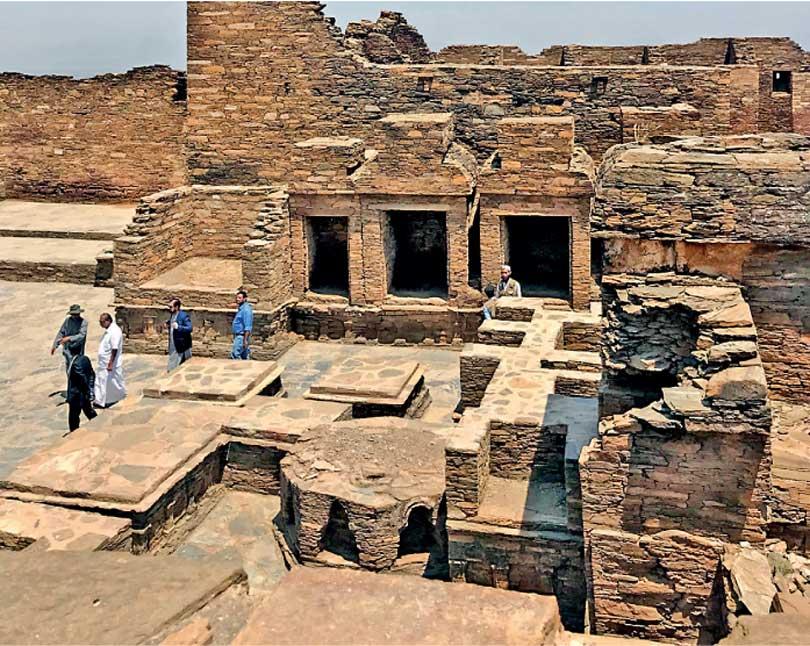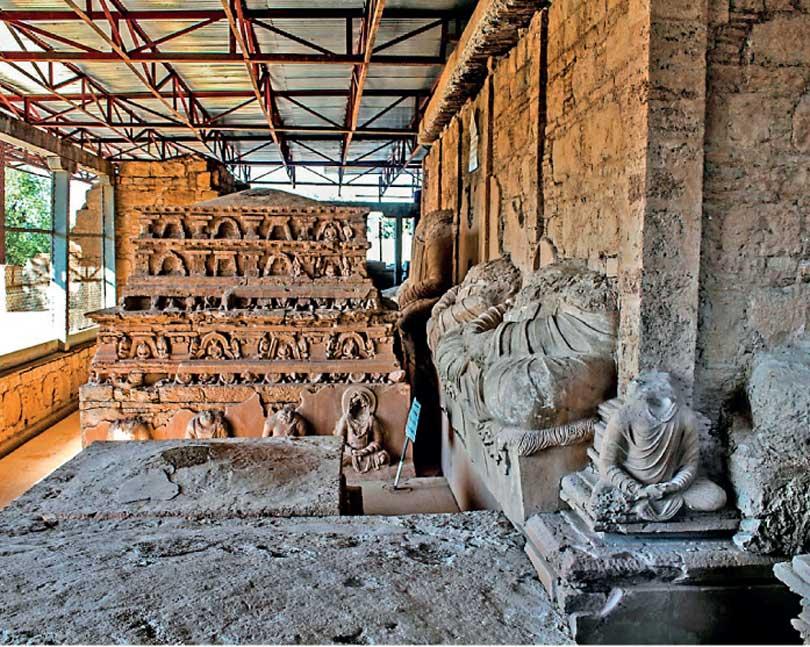Reply To:
Name - Reply Comment

Takht-i-Bahi monastic complex

Jaulian monastic complex
 In the green mountainous terrain coupled with the gorges and valleys of Pakistan, what is unfolding with immense grandeur is the cradle of the ancient Buddhist civilization of Gandhara.
In the green mountainous terrain coupled with the gorges and valleys of Pakistan, what is unfolding with immense grandeur is the cradle of the ancient Buddhist civilization of Gandhara.
Painstaking excavation under the supervision of renowned Pakistani archaeologists has led to the discovery of thousands of Buddhist heritage sites and artefacts.
Among them are stupas, statues of the Buddha in different postures including the famous fasting Buddha statue currently kept at the Lahore museum and the Maha Pari Nirvana statue in Bhamala, Taxila.
The remnants of centres of learning, found during excavations, proudly claim pretension to the modern university cities. All are nothing but the semblance of the flourishing Buddhist civilization that lasted for centuries in that part of the world.
Discovered, preserved and conserved with much effort, all these sites are now open for tourists from across the world, and the successive Pakistani governments have invested heavily in the promotion of them.
In its latest effort to showcase the rich Buddhist heritage to the world, the Pakistani government conducted an international symposium in Islamabad last month on the occasion of Vesak.
The Sri Lankan delegation that attended the event comprised Buddha Sasana, Religious and Cultural Affairs Minister Vidura Wickramanayaka. Among others were Ven. Halmillawewe Pemarathana Thero from the International Samanera Bhikkhu Training Institute, Dambulla, Ven. Prof. Thumbulle Seelakkhandha Thera, a member of the Sangha Council in Asgiri Maha Viharaya and former Vice-Chancellor of Pali and Buddhist University and Anuradhapura Bhikku University, Ven. Mugunuwela Anuradha Thera, General Secretary of the All Island Buddhist Council, and Ven. Tempitiye Indawimala, a lecturer at the Peradeniya University, High Commissioner of Sri Lanka in Islamabad Admiral Ravindra C. Wijegunaratne, also participated in the Symposium and Exhibition and Sri Lankan archaeologist Dr Thusita Wagalawatta also attended.
Following the two-day symposium in which scholars from Pakistan and some Buddhist countries made presentations on the Pakistani Buddhist heritage, visits were arranged to explore the renowned archaeological sites such as Jaulian and Bhamala Stupa, all of which hold a significant place on the World Heritage List.
First, after a journey from the Pakistani capital Islamabad, the delegates arrived at the historic monastic complex of Jaulian.
For Buddhist travellers, it allowed immersing themselves in the spiritual atmosphere of these archaeological cum sacred sites.
Ascending the hilltop, the visitors ended up in the monastic complex of Jaulian, which was included in the UNESCO World Heritage List in 1980.
Extending them a hearty welcome, field officer- Archaeology Syed Gul Kailash briefed in explicit detail the ancient history of the complex. Captivated by intricate details fleshed out in fine language, the visitors, particularly the Buddhist monks raised questions eager to know what the ancient Buddhist civilization would have looked like in the ancient past. She also briefed the steps taken for the upkeep of the place.
According to her, the original foundation of its remains dates back to the Kushan Period, in the 2nd century CE. The monastery at Jaulian had been home to one of the world’s oldest universities till its destruction in the 5th century CE.
With the presence of Buddhist monks from Sri Lanka, the site suddenly turned out to be a place of reverence as they started chanting Pirith to bless the place with spirituality.
Dr Abdul Samad, the Director of Archaeology and Museum, and his team are responsible for the conservation of this site in the Khanpur region.
Jaulian was once a thriving ancient city and centre of learning, especially regarding the Buddhist art and architecture of Gandhara.
Constructed in the early days of Buddhist expansion out of the Indian subcontinent in Gandhara, it played a key role in the spread of Buddhism along the Silk Road.
This city was home to many splendid Buddhist establishments important among them being Jaulian, the oldest university, a centre of learning from the 5th century BC to the 5th century AD.
In 2 BC Buddhism was adopted as the state religion which flourished and prevailed for more than 1,000 years, mainly in this area, according to Pakistani scholars. Jaulian consists of the main stupa and 27 subsidiary stupas located around it, and two adjacent courts. An additional 59 chapels are located around the courts and feature scenes from the Buddha’s life.
Today, the remains of this ancient university comprise mainly structures related to monastic life, including monk cells, an assembly hall and kitchen and store rooms.
The site was devastated in the 450s AD during the invasion of White Huns and later abandoned. Subsequent rulers such as the Hun King Mihirakula persecuted Buddhists living in the region.
Bhamala Buddhist Archaeology Complex
The Bhamala Buddhist Archaeology Complex that sits close to Khanpur Dam is another marvel that captivates heritage lovers.
The stupa and monastery that date back to the 2nd century CE are uniquely significant in the Gandhara civilization.
The discovery of the world’s oldest ‘Maha Pari Nirvana’ statue which depicts the passing away of Buddha is unique at this site.
The statue, discovered in 2016, is 1,700 years old and 48 feet long. It was found alongside a double-halo Buddha statue, the first of its kind to be found in the history of the Buddhist civilisation in Pakistan.
The members of the Sri Lankan delegation also showed keen interest in the world heritage site of Takht-i-Bahi in the Mardan district, the colonial-era Peshawar museum during the visit on Thursday and the famous Taxila museums.
The Buddhist Ruins of Takht-i-Bahi and Neighbouring City Remains are one of the most imposing relics of Buddhism in the Gandhara region of Pakistan. The inscribed property is composed of two distinct components both dating from the same era.
The Buddhist Ruins of Takhi-i-Bahi (Throne of Origins) is a monastic complex, founded in the early 1st century AD, is spectacularly positioned on various hilltops ranging from 36.6 metres to 152.4 metres in height, typical for Buddhist sites.
The Buddhist monastery was in continual use until the 7th century AD. It is composed of an assemblage of buildings and is the most complete Buddhist monastery in Pakistan.
The buildings were constructed of stone in Gandhara patterns (Diaper Style) using locally dressed and semi-dressed stone blocks set in lime and mud mortar.
A two-day symposium on Gandhara civilization held last month in Islamabad put the spotlight on Pakistan’s ancient cultural roots dating back thousands of years.
Several parts of the country were historically important centres of Buddhism during the Gandhara period, from around the 1st century BCE to the 7th century CE despite Pakistan not having any significant population of Buddhists today.
The Pakistani government has sought to develop religious tourism in these areas, mainly concentrated in the present-day Khyber Pakhtunkhwa and northern Punjab regions, and has regularly hosted Buddhist pilgrims and religious leaders in recent years.
That is being done as part of cultural diplomacy.
Minister Wickramanayake met Pakistani Minister for Religious Affairs and Interfaith Harmony, Chaudhry Salik Hussain who emphasized that all religions teach brotherhood, compassion, and caring which needs to be promoted.
At the meeting, the Sri Lankan Minister stressed the importance of cultural cooperation between the two countries and pledged Sri Lankan assistance to Pakistan in this case.
The Minister said the preservation of Gandhara culture, art, and structures is being preserved in Pakistan. Minister Salik Hussain highlighted that Pakistan is taking care of many holy places of Sikhs and other religions in Hasan Abdal.
Sri Lanka is duty-bound in this case as a predominantly Buddhist country. The Buddha’s tooth relic is also kept at the Taxila Museum making it a place as significant as historic Dalada Maligawa in Kandy from a religious perspective.